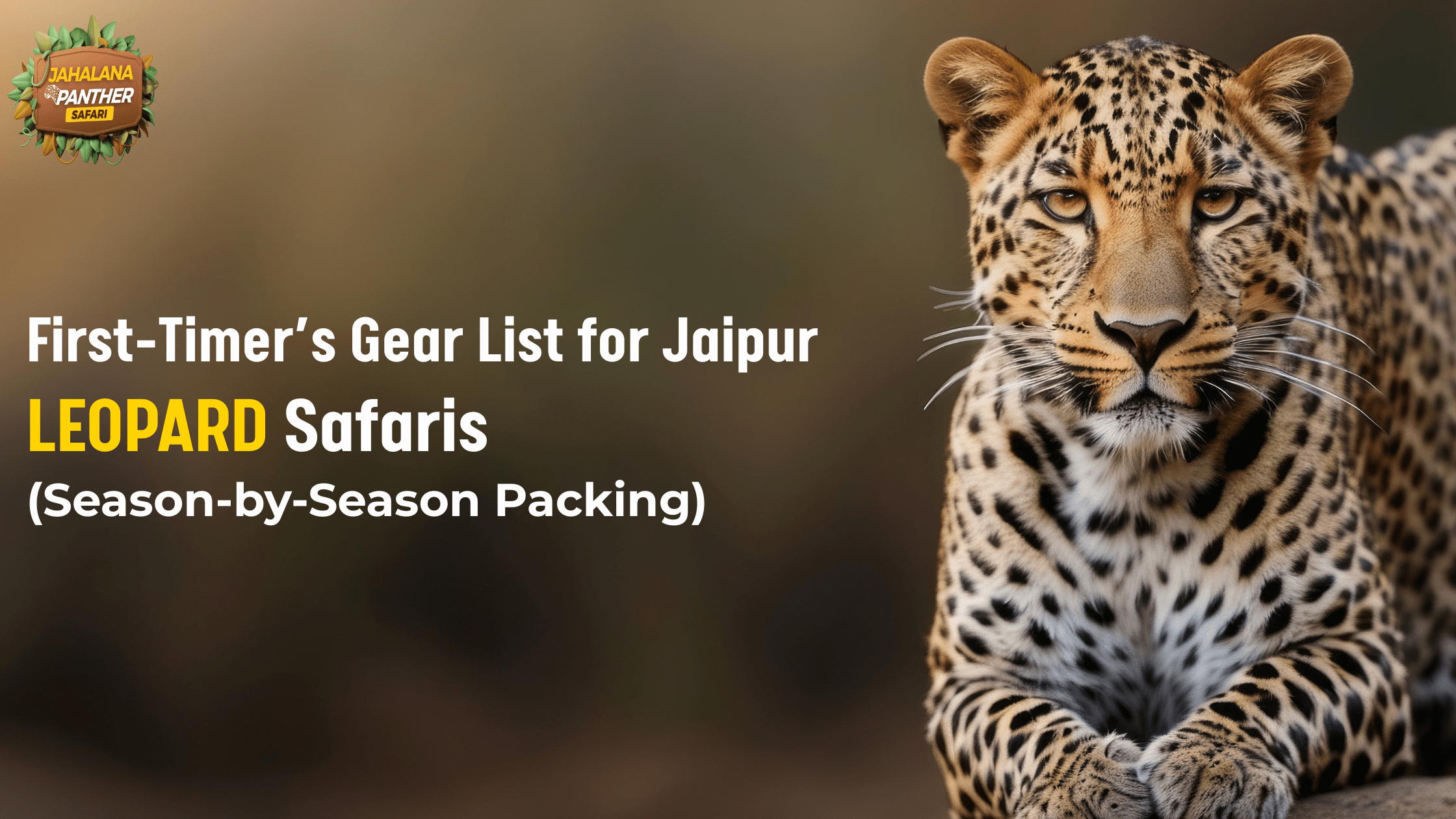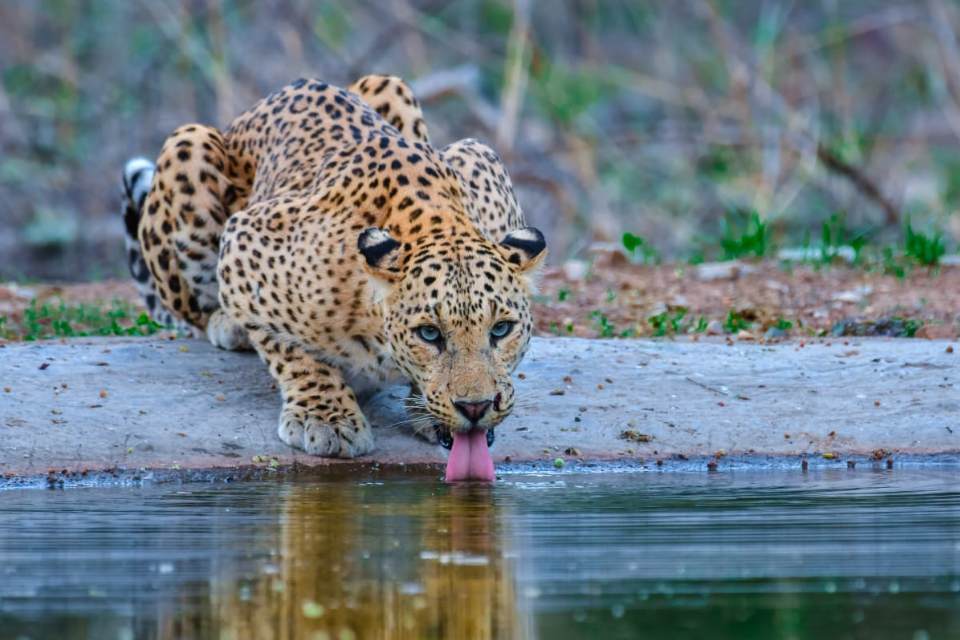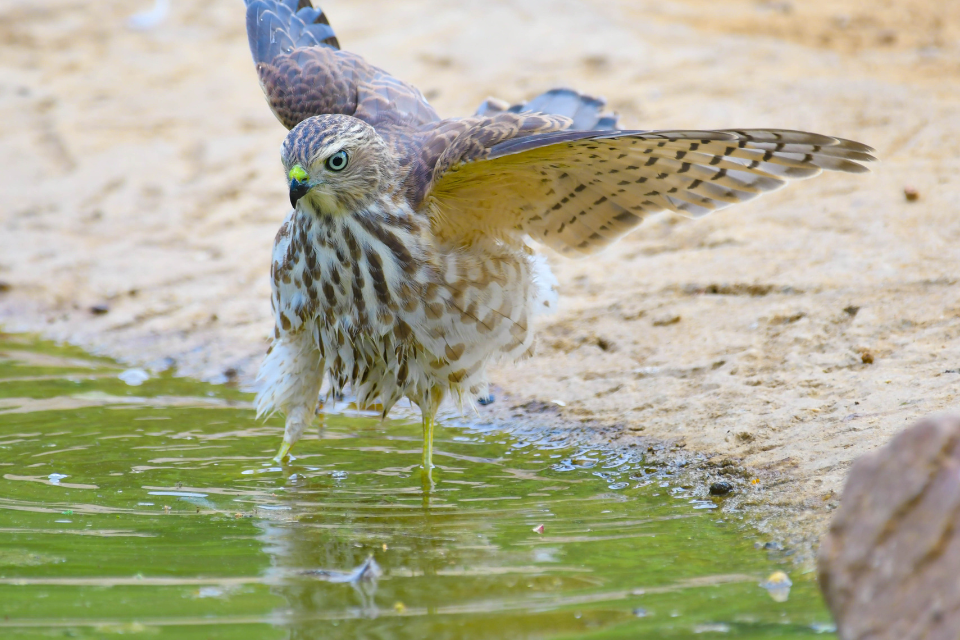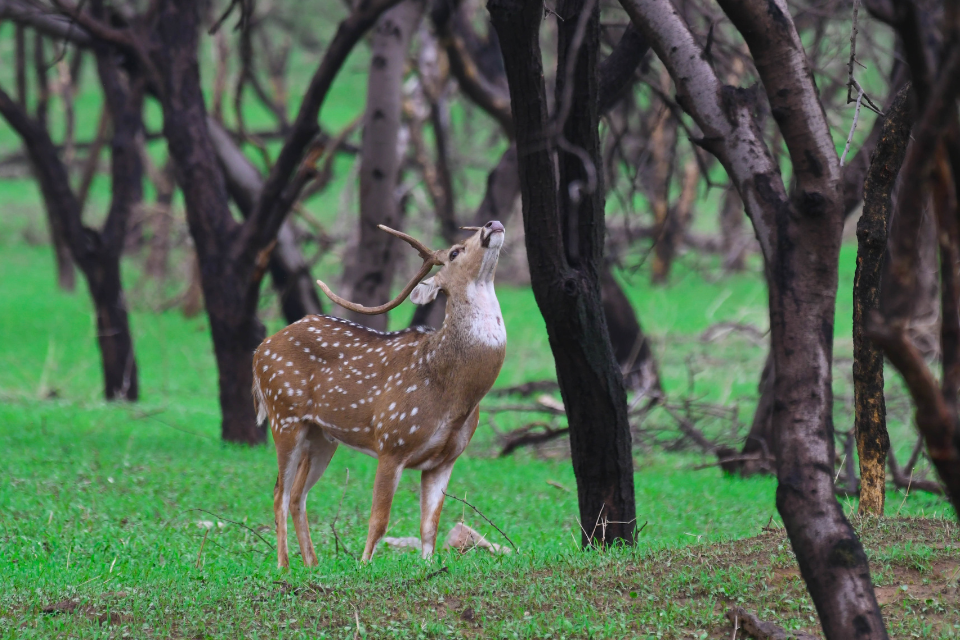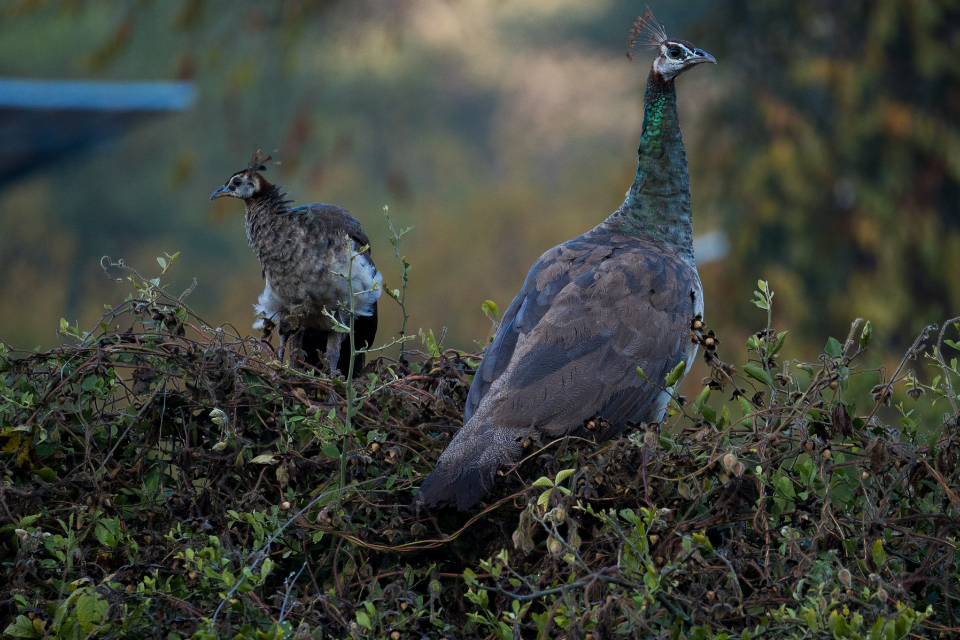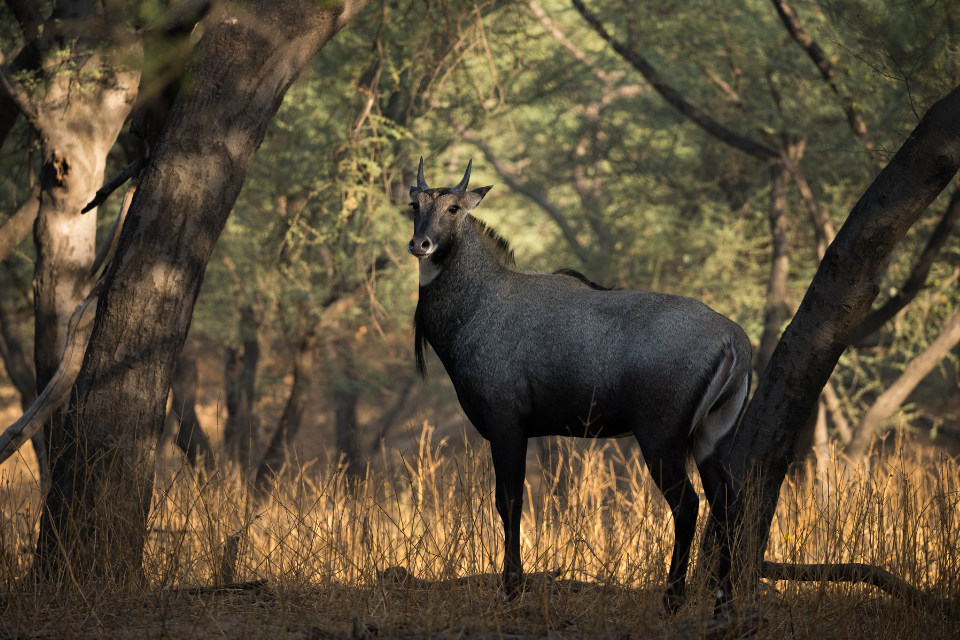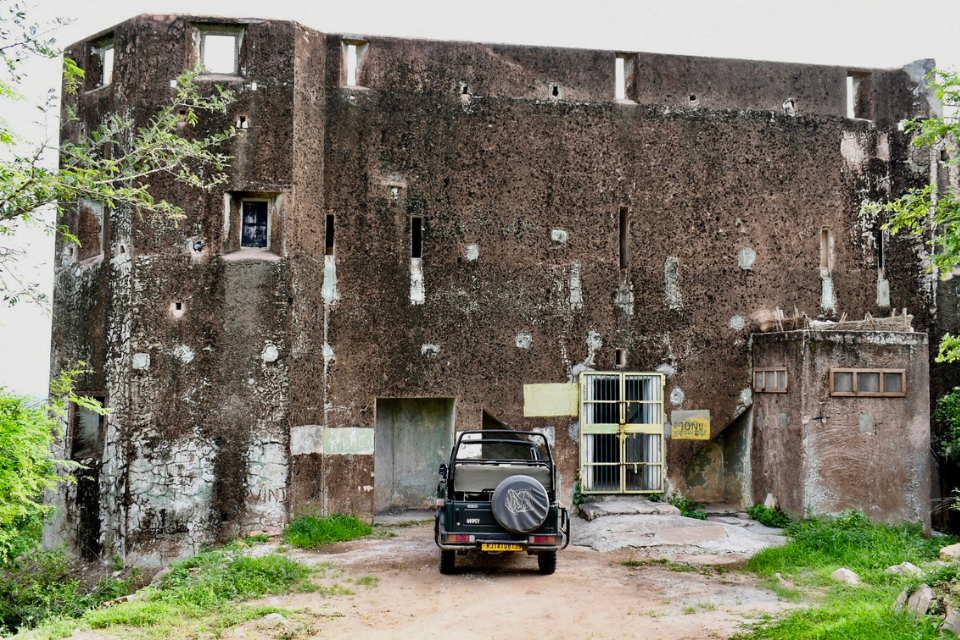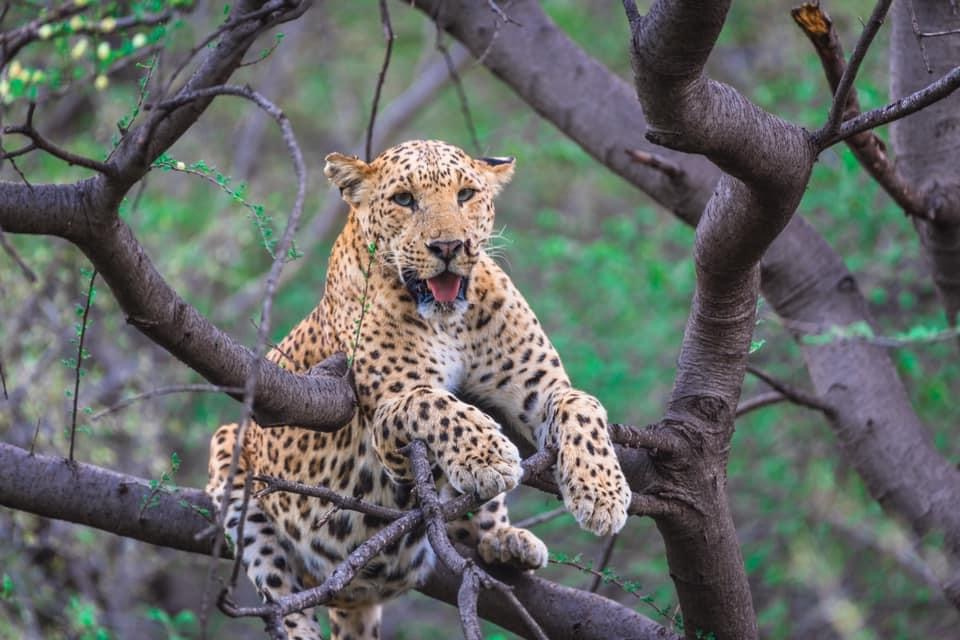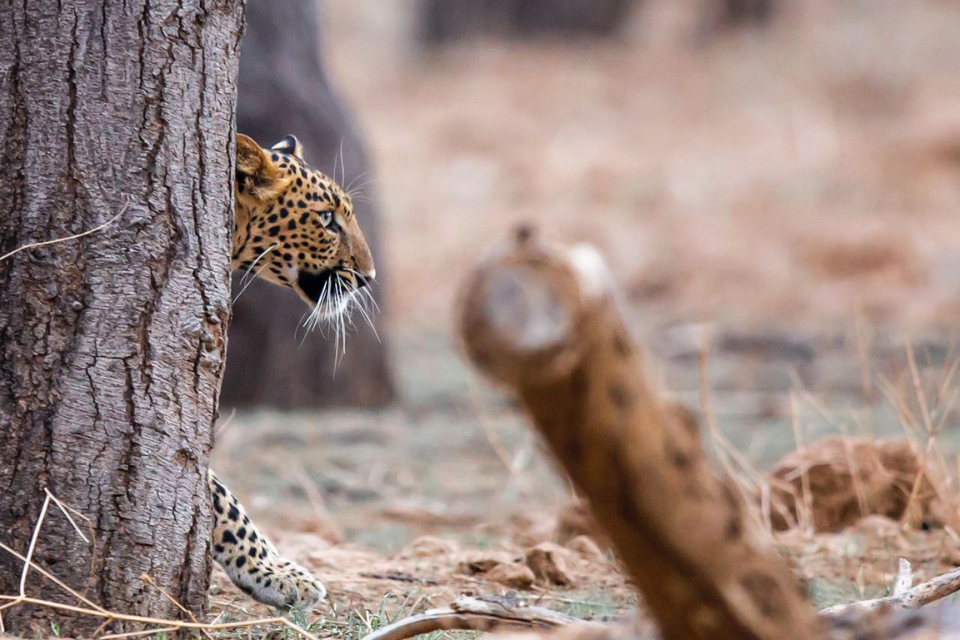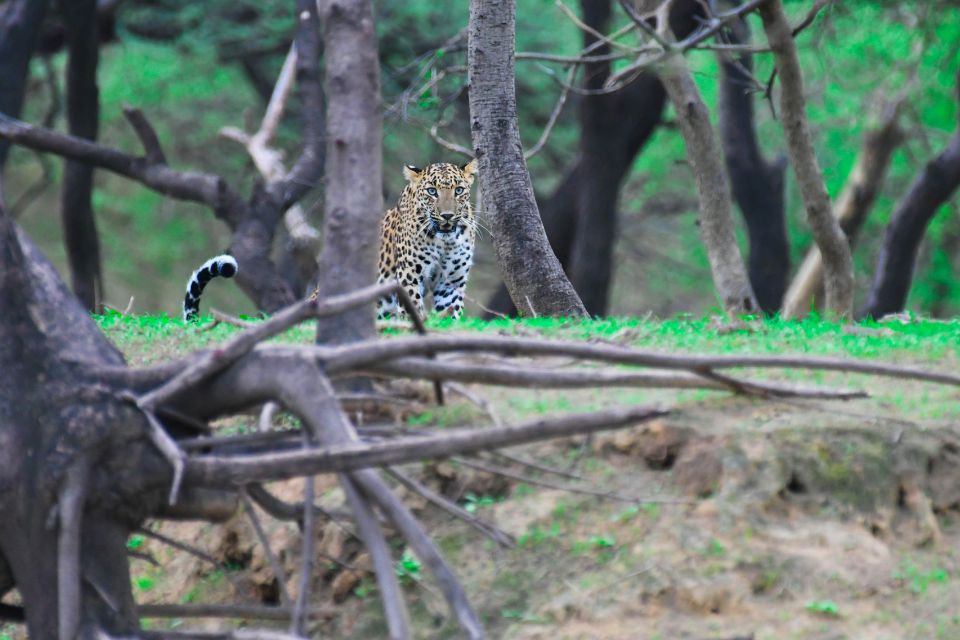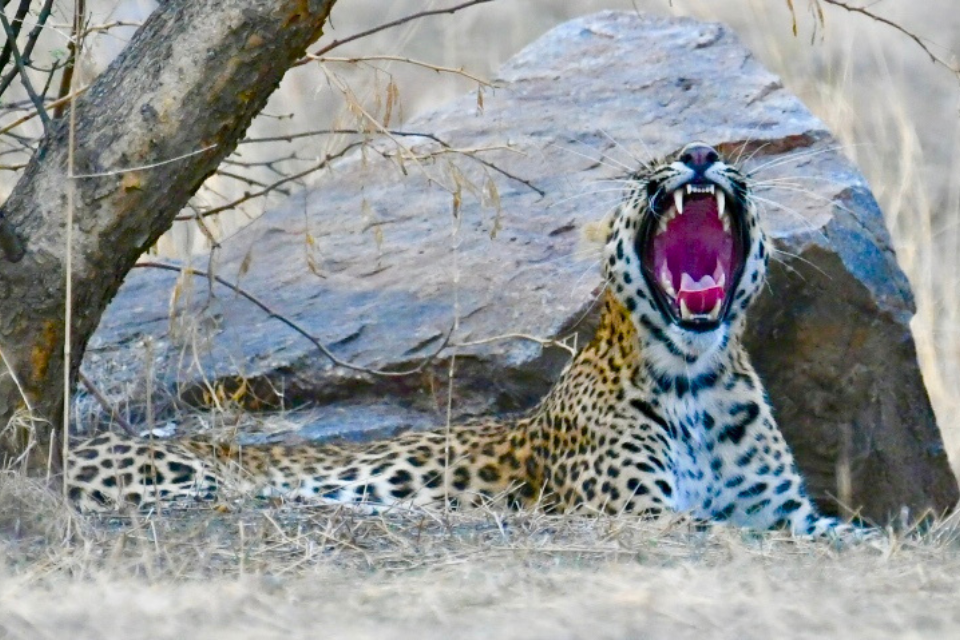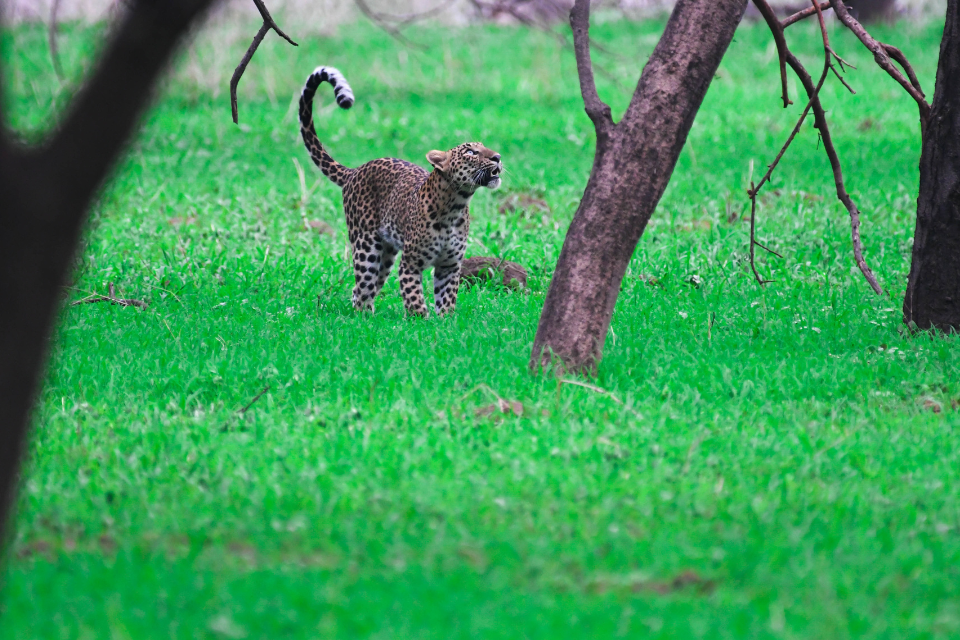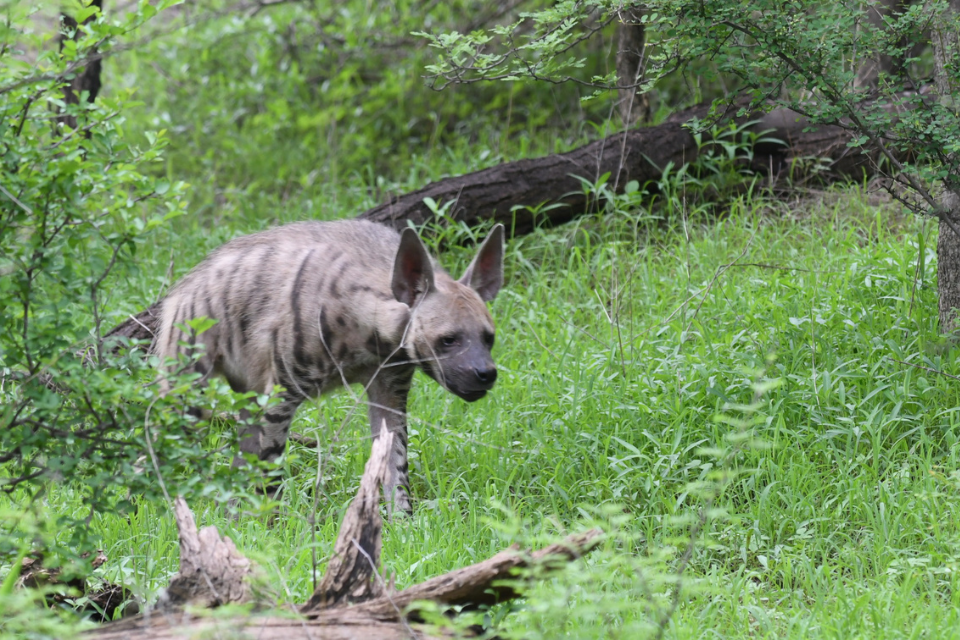- October 9, 2025
First-Timer’s Gear List for Jaipur Leopard Safaris (Season-by-Season Packing)
Leopards around Jaipur are famously elusive, and the terrain swings from arid scrub to rocky ravines. That means your packing choices matter a lot more than you’d think. This guide breaks down month-by-month clothing, recommended lens focal lengths, dust and monsoon protection, and a complete Jaipur safari packing list so first-timers can plan confidently. You’ll also find a simple call-to-book if you want us to set up a responsible, well-equipped ride.
TL;DR (Skim-Friendly)
- Wear earth tones (olive, tan, brown, grey); avoid bright whites, neon, and noisy fabrics.
- Camera kit that works year-round: APS-C: 100–400mm (or 150–600mm), Full-frame: 200–500/600mm; add a 24–70/105mm for habitat.
- Pack dust covers, microfiber cloths, blower, and zip-top bags. In monsoon, add rain sleeves, dry bags, and anti-fog wipes.
- Morning drives are chilly Nov–Feb; bring mid-layer + windproof. May–June is scorching: breathable shirts, sun hat, electrolytes.
- Footwear: closed-toe trail shoes with grippy soles; flip-flops only for lodge wear.
- Binoculars 8×42 or 10×42, soft beanbag for vehicle rail, no tripods in vehicles (a monopod is OK if your operator allows and it doesn’t disturb others).
- Keep your main kit in a 20–30L daypack with silica gel and spares (batteries/cards) in a waterproof pouch.
The Packing Philosophy (Why It Works in Jaipur)
Blend in and stay quiet. Leopards are crepuscular and wary. Neutral colors reduce visual noise; soft fabrics reduce rustle when you shift in the jeep.
Plan for rapid swings. Pre-dawn chills flip to hot, dusty afternoons even in winter. Layering beats one heavy jacket.
Protect optics first. Jaipur’s scrubland equals fine dust. Keep a lens mounted, change lenses sparingly, and use sealed zooms where possible.
Carry smart, not heavy. The best safari bag is the one you can lift easily in a bumpy vehicle and manage quickly when a sighting unfolds.
Month-by-Month: What to Wear & Pack
Use this section exactly as a “what to wear leopard safari Jaipur” planner. Temperatures vary by year; think in terms of “feel” and layer accordingly.
January
- Feel: Cold mornings, mild afternoons; dry air.
- Wear: Thermal base (optional), long-sleeve tee, fleece mid-layer, windproof shell, convertible trousers, buff.
- Camera: Light is soft; animals bask. 400–600mm reach helpful; carry 24–70mm for golden-hour habitat frames.
- Extras: Thin gloves, hand warmers, lip balm, thermos for tea.
February
- Feel: Crisp mornings, comfortable days.
- Wear: Long-sleeve shirt + light fleece or softshell; packable windbreaker.
- Camera: 100–400mm/200–500mm; consider 1.4x teleconverter.
- Extras: Polarized sunglasses, sunscreen (UV ramps up).
March
- Feel: Warming fast; dust picks up.
- Wear: Breathable, light long sleeves (synthetic or merino), sun hat with strap.
- Camera: Midday haze; prefer stabilized lenses; keep a blower handy.
- Extras: Electrolyte sachets, neck gaiter for dust.
April
- Feel: Hot, bright, dry.
- Wear: Ultralight long sleeves, UPF-rated shirts, airy trousers; avoid shorts (sun + scrapes).
- Camera: Heat shimmer at distance—compose tighter; 400–600mm still useful.
- Extras: Cooling towel, 2L hydration, zinc sunscreen.
May
- Feel: Peak heat; afternoon thermals and dust.
- Wear: Max-breathable kit, wide-brim hat, sweat-wicking socks.
- Camera: Shimmer and harsh light—shoot early/late, use lens hood religiously.
Extras: Electrolytes, oral rehydration, saline eye drops.
June
- Feel: Very hot; pre-monsoon gusts, occasional storm.
- Wear: Same as May + light rain shell for sudden squalls.
- Camera: Dust control critical—rain/dust sleeve on lens body; keep spare body in bag.
- Extras: Dry bag for electronics; microfiber x3.
July
- Feel: Monsoon begins; cooler but humid; intermittent showers.
- Wear: Quick-dry layers, waterproof shell, fast-drying trousers; pack a second pair.
- Camera: Rain covers, dry bag, anti-fog wipes; keep desiccants in bag overnight.
- Extras: Waterproof phone pouch, towel, spares in zip-tops.
August
- Feel: Rains continue; lush, green landscape.
- Wear: As July; add lightweight gaiters if you expect muddy entries/exits.
- Camera: Lusher foliage = closer encounters if luck strikes; 70–200mm or 24–105mm useful alongside a long zoom.
- Extras: Dehumidifier bags for your room to protect gear.
September
- Feel: Showers taper; mornings fresh, midday sticky.
- Wear: Breathable long sleeves + packable shell.
- Camera: Mixed light; circular polarizer to cut glare on wet foliage (use sparingly to avoid dark skies).
- Extras: Spare socks, microfiber for seat rails.
October
- Feel: Post-monsoon clarity; warm days, pleasant mornings.
- Wear: Long-sleeve shirt, light fleece for dawn, airy trousers.
- Camera: Great month for wide environmental shots (24–70/105mm) + 100–400mm for cats.
- Extras: Insect repellent (standing water may linger).
November
- Feel: Cool mornings, comfortable days; dust returns.
- Wear: Layered long sleeves + light jacket at dawn.
- Camera: Beanbag for low-light steady shots; prime 300/400 if you prefer extra sharpness.
- Extras: Buff for dust, hot beverage flask.
December
- Feel: Chilly dawns, mild afternoons; very dry.
- Wear: Base layer (optional), fleece, windproof shell, beanie.
- Camera: Golden, low sun; reach matters as undergrowth dries and sightings can be at mid-distance.
Extras: Moisturizer, nasal saline, hand warmers.
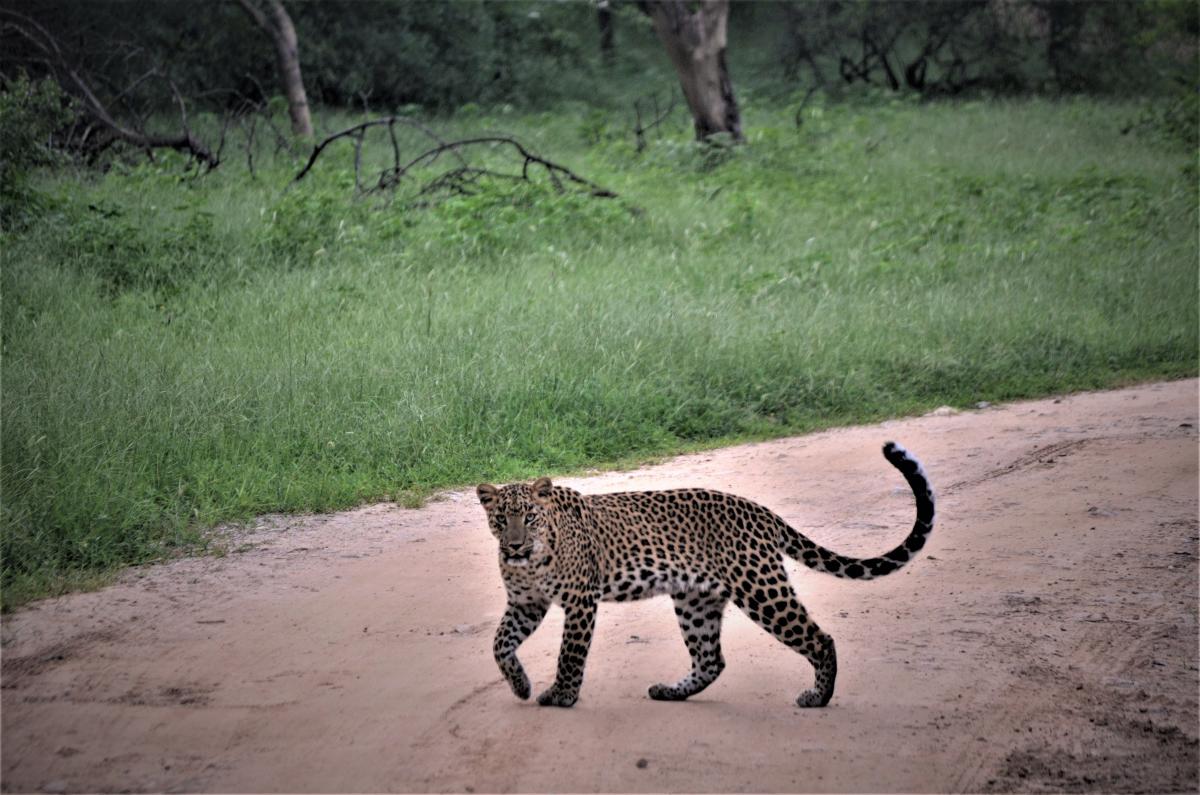
Camera Gear: Focal Lengths & Practical Setups
Bodies
- Any modern APS-C or full-frame body with good AF and stabilization. Higher burst rates help with fleeting leopard movement.
Lenses (pick based on budget/weight)
- APS-C: 100–400mm or 150–600mm is the sweet spot.
- Full-frame: 200–500mm/200–600mm; pair with 24–70/105mm for landscapes, jeepscapes, and close interactions (think peacocks, antelope, habitat).
- Primes: 300mm f/2.8 or 400mm f/2.8 for speed and subject isolation—if you can manage weight and cost.
Support
- Beanbag over the vehicle rail beats a tripod. Monopods are fine if space allows and your guide agrees.
- Straps/Slings to keep a second body ready without banging metal on the vehicle.
Filters & Accessories
- Lens hood always. CPL only when needed (wet leaves/sky contrast); avoid over-polarizing.
- Plenty of cards (UHS-II or CFexpress where applicable), 2–3 batteries per body/day.
- Blower, soft brush, 3–4 microfibers, pre-cut wet wipes for body (never for bare lens elements).
- Rain/dust sleeves, dry bags, silica gel (bake to recharge after the trip).
Dust & Monsoon Protection (Your Gear’s Survival Plan)
- During dust: Keep one lens mounted; turn your back to the wind when swapping. Use zip-top bags as emergency dust sleeves.
- During rain: Put everything into a roll-top dry bag inside your daypack. Fit rain covers before you set off; it’s easier than scrambling mid-downpour.
- At the lodge: Store gear in a hard case or on a shelf with silica gel; never on the floor. If humidity is high, run the room’s fan/AC to discourage condensation.
Anti-fog: Use anti-fog wipes and keep a spare lens cloth in a separate, sealed pocket.
Clothing & Footwear: Field-Tested Picks
- Tops: Long-sleeve breathable shirts (synthetic or merino), light fleece/softshell, packable windproof.
- Bottoms: Tough, quick-dry trousers; convertible legs for heat; avoid shorts during drives.
- Headwear: Wide-brim hat (with chin strap), beanie in winter, buff for dust/sun.
- Footwear: Closed-toe trail shoes with grip; ankle support helps on rocky ground.
- Socks: Wicking socks; carry a spare pair on rainy days.
- Colors: Earth tones. Skip white/black/bright camo patterns; respect local guidelines and avoid anything that imitates official uniforms.
The Daypack (20–30L) Layout
- Top: Camera body + tele zoom (mounted), lens hood out.
- Front pocket: Cards, batteries, blower, microfiber, anti-fog, lip balm.
- Main compartment: Second lens/body in padded cube, beanbag (deflated), rain cover.
- Side: Water bottle (1–2L) or hydration sleeve; electrolytes in quick-access pocket.
- Hidden/flat: First-aid mini-kit, copy of permits/ID, cash in small notes, gaffer tape wrapped on a pencil, zip ties.
Health & Comfort Add-Ons
- Electrolytes (single-serve).
- Sun protection (broad-spectrum, SPF lip balm).
- Insect repellent for post-monsoon evenings.
- Med kit: personal meds, blister care, pain reliever, band-aids.
- Seat pad/blanket for comfort on long tracks.
- Headlamp with red mode for hands-free post-sunset packing at the lodge.
The Jaipur Safari Packing List (Copy-Paste)
Clothing
- 2–3 long-sleeve breathable shirts (earth tones)
- 2 quick-dry trousers (1 convertible)
- 1 fleece/softshell + 1 windproof shell (Nov–Feb: add base layer/beanie/gloves)
- Wide-brim hat + buff/neck gaiter
- 3–4 pairs wicking socks; spare pair in daypack
- Closed-toe trail shoes
Camera & Optics
- DSLR/Mirrorless body (+ spare if you have it)
- Tele zoom: 100–400/150–600 (APS-C) or 200–500/200–600 (FF)
- Standard zoom: 24–70/24–105
- Optional: 1.4x teleconverter, fast prime
- Binoculars 8×42/10×42
- Beanbag; strap/sling
Protection & Maintenance
- Rain/dust sleeves, lens hood, body rain cover
- Dry bags/pack cover, silica gel, anti-fog wipes
- Blower, soft brush, 3–4 microfibers, pre-cut wet wipes (for body only)
Power & Storage
- 2–3 batteries per body/day
- 2–3 high-speed memory cards (don’t put all eggs in one basket)
- Multi-plug adaptor, fast charger, power bank
Comfort & Health
- 1–2L water bottle/hydration pouch
- Electrolytes, snacks (nuts/energy bars)
- Sunscreen, insect repellent (post-monsoon), lip balm
- Mini first-aid
- Light towel (monsoon)
Common First-Timer Mistakes (And How to Avoid Them)
- Over-packing lenses. Two lenses (long zoom + standard zoom) cover 95% of situations.
- Ignoring dust. One unprotected lens change can ruin a day’s set. Pre-fit covers and carry a blower.
- Wearing bright colors. They draw attention and reflect in windows/metal—stick to earth tones.
- Skipping electrolytes. Dehydration sneaks up fast in heat and dust.
- Relying on a tripod. Vehicles move; a beanbag is steadier and friendlier for everyone.
Ready to Go? Book With Us for a Seamless First Safari
We’ll set up permits, naturalist-led drives, and a vehicle configured for photographers (beanbags, clean rail space, and sensible seating). Want a loaner 100–400mm or rain covers? Tell us in advance.
👉 Book your Jaipur Leopard Safari for dates, gear add-ons, and a friendly pre-trip checklist mailed to you.
FAQs (8–10 Quick Answers)
1) What’s the single most important item on a Jaipur safari packing list?
A long telephoto zoom (100–400mm or 200–500/600mm) with a beanbag. You can improvise clothes, but you can’t invent reach or stability on the fly.
2) Exactly what to wear leopard safari Jaipur in winter?
A long-sleeve base, fleece, and a windproof shell at dawn, with breathable trousers and closed-toe shoes. Add a beanie/buff for the first hour.
3) Is camouflage clothing okay?
Stick to plain earth tones. Avoid military-pattern camouflage and any clothing that resembles official uniforms; neutral solids are perfect and respectful.
4) Are tripods allowed in vehicles?
Generally no; they’re cumbersome and unsafe in moving vehicles. Use a beanbag or a monopod only if space and guides allow.
5) Do I need two camera bodies?
Not mandatory, but helpful: one long lens mounted, one standard zoom ready. If you carry one body, plan your lens choice before each drive and avoid mid-drive swaps.
6) Which binoculars are best for first-timers?
8×42 (wider, brighter, steadier) or 10×42 (more reach). Choose a model with decent eye relief and a comfortable strap.
7) How do I protect gear in monsoon?
Use rain sleeves, stash electronics in dry bags, keep silica gel in your pack, and wipe down gear after each drive. Carry anti-fog for viewfinders.
8) Can I wear shorts?
You can, but we don’t recommend it. Sun, thorny scrub, and vehicle rails are kinder to covered legs. Lightweight trousers are cooler than you think.
9) How many batteries and cards should I bring?
Plan 2–3 batteries per camera per day and multiple 64–128GB cards. Swapping cards reduces the risk of a single-card failure nuking your trip.
10) Are sandals okay?
Save them for the lodge. On drives and rocky pull-outs, closed-toe trail shoes protect your toes and grip better.
Disclaimer All images used in this blog are either sourced from public domain or credited to their respective owners. If you are the copyright holder of any image and wish to request its removal or proper attribution, please contact us at [email protected]
